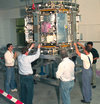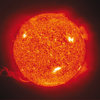Applications of Ion Beam Research
Research with heavy ions has led to diverse applications and technological innovations in the past. The most spectacular example is the development of a new tumor therapy employing precision ion beams, which is presently being tested with most promising results.
As in the past, the proposed facility, too, will push forward new developments, some of which will eventually lead to specific applications. At present one can discern several areas for such applications.
New probes and techniques for Solid State Physics and Materials Research
Radioactive atoms are being used very successfully as probes to study processes and the properties of materials. The FAIR-facility will enable the use of new radioactive probes for such studies and, when necessary, make them available as isotopically pure secondary beams. The high energy of the secondary beams also results in new possibilities in other areas. One can implant the probes through thick walls - in high-pressure cells, for example - and in this way study material properties under extreme conditions.
Radiobiological risk assessments for manned space missions
In manned space missions, astronauts are exposed to high levels of radiation, and this will particularly be the case in the planned extended-duration flights to Mars. Little is thus far known about the radiobiological effect of the high-energy components of cosmic radiation. Even when the particle fluxes at these high energies decrease drastically, secondary reactions in the walls of the spacecraft and particle showers resulting from them can add significantly to the overall exposure. With the beam energies available at the proposed facility, these effects can be studied, and the risks they pose to astronauts assessed.
Test equipment for satellites or spacecraft components
During their missions, satellites and spacecraft are exposed to cosmic radiation, especially high-energy protons, helium nuclei and other heavy ions up to and including iron. This can lead to the corruption of information or permanent damage in electronic chips and, in extreme cases, jeopardize the entire mission. Accelerator systems make it possible to simulate cosmic radiation.
The FAIR-facility allows us to examine not only individual components but also whole systems, including satellites or spacecraft components, and to do so throughout the relevant energy range of cosmic radiation.
Studies on the creation of fusion plasmas through inertial confinement
The high-intensity ion pulses delivered by the new accelerator complex enable scientists to create hot, dense plasmas. In addition to its significance for basic research, this phenomenon also carries a long-term interest for its possible applications. For example, this research could indicate new ways of achieving the fusion of hydrogen into helium in the laboratory and for harnessing this process so as to supply energy in the distant future. Together with the high-energy/high-power laser PHELIX currently installed at GSI, the proposed accelerator facility creates ideal experimental conditions for research into the basic physics aspects of inertial confinement fusion.






